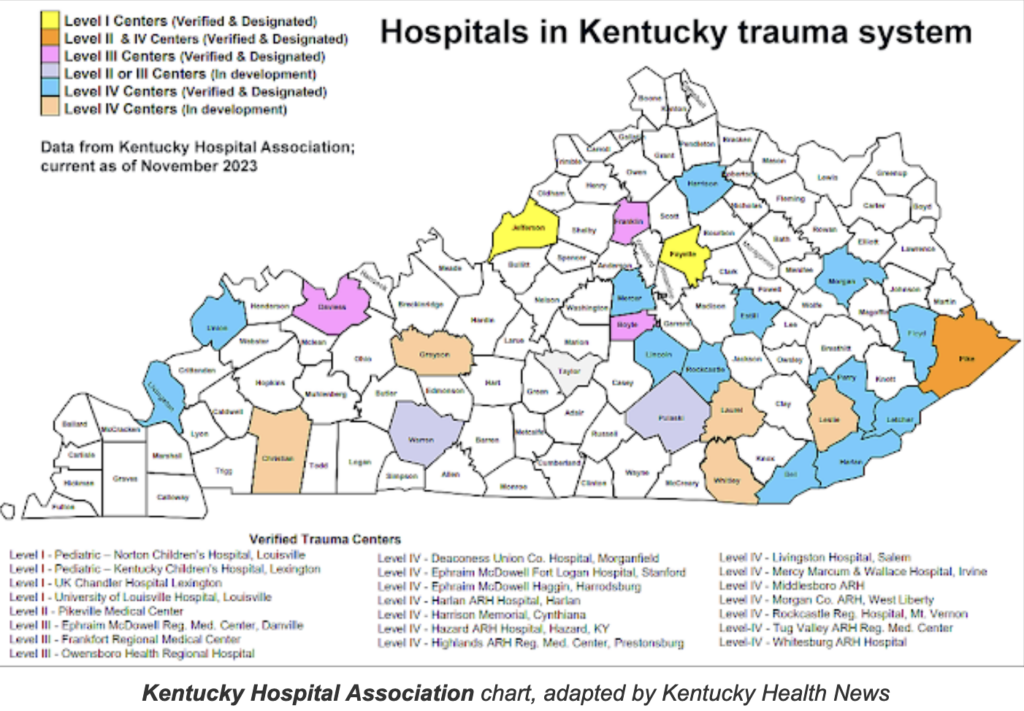Rural trauma deaths could be reduced if ambulances could bill insurance companies for delivering blood en route to the hospital

Kentucky Health News
In 2020, a traumatic injury killed an American every 31½ minutes, and such injuries are the top killer of children and adults under 45. Those statistics could be better if more ambulances carried blood, Lauren Caruba of the Dallas Morning News reports in a package with the San Antonio Express-News.
The problem is worst in the sparsely populated West, but “parts of the South performed worse compared with the coasts,” Caruba reports. The package focuses on western Colorado and has an interactive map showing how far every location in the 48 contiguous states is from a trauma center. The part of the map centered on Kentucky shows that from most of the state, Level I and II trauma centers are more than half an hour, when deaths from bleeding peak.
 “The solution is straightforward: If paramedics widely carried blood, as military medics have done for years, tens of thousands of lives could be spared annually. But the country’s fragmented health-care system does not allow for an easy fix. . . . Despite repeated pleas from specialists, the federal government has not prioritized or properly invested in the plight of injured Americans.”
“The solution is straightforward: If paramedics widely carried blood, as military medics have done for years, tens of thousands of lives could be spared annually. But the country’s fragmented health-care system does not allow for an easy fix. . . . Despite repeated pleas from specialists, the federal government has not prioritized or properly invested in the plight of injured Americans.”
The Defense Department has greatly improved combat death rates with faster evacuation, “increased tourniquet use and administered blood on the way to the hospital,” Caruba notes. “No such overhaul has happened in U.S. health care, and efforts have not been made to broadly adopt the military’s best practices, particularly before patients reach a hospital.”
In 2019, fewer that 1% of trauma patients “received blood products of any kind on the way to the hospital, even when they displayed clear warning signs of bleeding out,” Caruba reports, citing research by the University of Alabama-Birmingham. She notes that there is relatively little research into trauma deaths, and that the federal government doesn’t even track them. But a federal report in 2016 estimated that over the previous decade, 200,000 to 300,000 trauma deaths were potentially avoidable.
The U.S. has more than 23,000 emergency medical services, “but only about 100 ground ambulance services have blood on hand, trauma advocates have found in recent surveys. While most air ambulance companies carry blood products, they treat only a small fraction of injured patients,” Caruba reports. “Blood is a costly, limited resource, and most emergency medical providers lack relationships with blood banks. They also face regulatory and logistical hurdles, like maintaining blood refrigeration temperatures in the field and creating a system where unused units do not go to waste.”
The Prehospital Blood Transfusion Initiative Coalition is focusing on the servcies’ “inability to bill insurers for the cost of the blood and the rules in some states that prevent paramedics from starting transfusions,” Caruba reports. “The group hopes to present recommendations to Congress and the National Association of State EMS Officials next year. Their goal is that every patient with major bleeding — including the injured and those hemorrhaging from medical complications — will receive blood if they need it.”